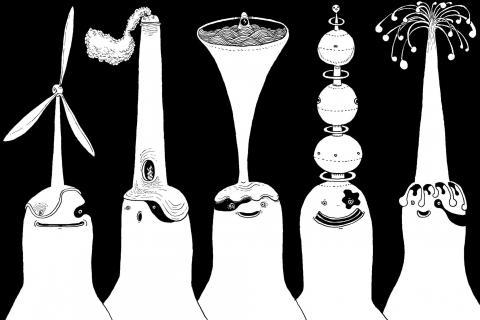Renewable energy triggers sharply polarized views. For some, it is a costly white elephant; for others, it is humanity’s savior, promising to emancipate us (and our environment) from the “folly” of fossil fuels. So a hardheaded, credible and, above all, impartial analysis, which would provide a much-needed dose of pragmatism and realism to the debate, is long overdue.
The new report by the UN Intergovernmental Panel on Climate Change (IPCC), involving more than 120 scientists, economists and technology specialists, provides that long-overdue assessment. It adopts a global perspective and reconciles developed and developing countries’ interests, while weighing the broader economic, environmental and social issues at stake.
The summary, signed by representatives of the more than 190 countries meeting this week in the United Arab Emirates, concludes that renewable energy is an increasingly practical and highly promising option. Costs are falling — and are likely to fall even further as innovation accelerates and global demand for energy continues to rise.

The researchers have painstakingly sifted through more than 160 scenarios, including in-depth examinations of four. The most optimistic of these predicts that renewables could account for almost 80 percent of total energy supply by mid-century, thereby cutting greenhouse-gas emissions by about one-third.
Of course, only time will tell whether or not this figure can be reached. Some of the six renewable-energy technologies evaluated, such as those that generate electricity from the ocean, will require more research, development and incubation before they reach commercial maturity. However, others, such as wind, solar and geothermal are in some circumstances already cost competitive — or nearly cost competitive — with fossil fuels.
The IPCC report also underscores what some development experts and economists have been saying for years: Energy choices should take into account wider benefits. Renewables cut air pollution, which is costing the global economy billions of US dollars a year in health-care costs alone. Photovoltaics can be rapidly deployed in rural areas without the need to instal an expensive grid system — Bangladesh is a pioneering case in point. Moreover, we are only just coming to grips with the cooling costs of thermal power plants in terms of finite water resources — let alone the future price of unchecked climate change.
The ball is now firmly in the politicians’ court. The IPCC assessment points out that renewables are already growing. In 2009, installed capacity of wind and photovoltaics increased by more than 30 percent and 50 percent, respectively. However, the really big numbers are unlikely to be reached without the kinds of supportive public policies that have catalyzed the expansion of renewables in countries such as China and Germany.
Smart and forward-looking national policies are imperative. Kenya’s new feed-in tariff has triggered a rapid expansion of geothermal capacity, and, at 300MW, the largest wind-farm project in sub-Saharan Africa.
However, diverse national policies can achieve only so much. International policies, including the lending decisions of the World Bank and regional development banks, must evolve along with the strategies of the UN and bilateral donors.
The importance of moving forward on a new global climate agreement in Durban, South Africa, this year cannot be underestimated. A comprehensive agreement would bring certainty to the carbon markets and strengthen the various mechanisms that are already encouraging renewables in developing economies and pump-priming private-sector investments. The Rio Plus 20 meeting in Brazil next year is another opportunity to spark the transition to a global green economy.
Technical challenges remain: Seamlessly managing an array of very different energy sources will require investment in better national and regional grids. Yet the opportunities — to keep the global temperature rise this century to under 2?C, and to generate decent employment in clean-tech industries for millions of people — far outweigh the challenges. Clean and renewable energy will be an indispensable component of the fight against poverty worldwide.
The IPCC estimates that the costs of triggering a renewable revolution could range from US$3 trillion to more than US$12 trillion between now and 2030. That sounds pricey — and it is. However, fossil-fuel subsidies are currently running at more than US$600 billion a year, with barely a murmur of protest.
The IPCC report has provided a solid, scientific foundation for a low-carbon, resource-efficient future. Governments now have a clearer perspective on how to empower the lives and livelihoods of the world’s 7 billion people (9 billion to 10 billion by 2050), while keeping humanity’s footprint, including climate change, within the planet’s boundaries of environmental sustainability.
Achim Steiner is executive director of the UN Environment Program. Helen Clark, a former prime minister of New Zealand, is administrator of the UN Development Program. Kandeh Yumkella is director-general of the UN Industrial Development Organization.
COPYRIGHT: PROJECT SYNDICATE
The government and local industries breathed a sigh of relief after Shin Kong Life Insurance Co last week said it would relinquish surface rights for two plots in Taipei’s Beitou District (北投) to Nvidia Corp. The US chip-design giant’s plan to expand its local presence will be crucial for Taiwan to safeguard its core role in the global artificial intelligence (AI) ecosystem and to advance the nation’s AI development. The land in dispute is owned by the Taipei City Government, which in 2021 sold the rights to develop and use the two plots of land, codenamed T17 and T18, to the
Taiwan’s first case of African swine fever (ASF) was confirmed on Tuesday evening at a hog farm in Taichung’s Wuci District (梧棲), trigging nationwide emergency measures and stripping Taiwan of its status as the only Asian country free of classical swine fever, ASF and foot-and-mouth disease, a certification it received on May 29. The government on Wednesday set up a Central Emergency Operations Center in Taichung and instituted an immediate five-day ban on transporting and slaughtering hogs, and on feeding pigs kitchen waste. The ban was later extended to 15 days, to account for the incubation period of the virus

The ceasefire in the Middle East is a rare cause for celebration in that war-torn region. Hamas has released all of the living hostages it captured on Oct. 7, 2023, regular combat operations have ceased, and Israel has drawn closer to its Arab neighbors. Israel, with crucial support from the United States, has achieved all of this despite concerted efforts from the forces of darkness to prevent it. Hamas, of course, is a longtime client of Iran, which in turn is a client of China. Two years ago, when Hamas invaded Israel — killing 1,200, kidnapping 251, and brutalizing countless others
Art and cultural events are key for a city’s cultivation of soft power and international image, and how politicians engage with them often defines their success. Representative to Austria Liu Suan-yung’s (劉玄詠) conducting performance and Taichung Mayor Lu Shiow-yen’s (盧秀燕) show of drumming and the Tainan Jazz Festival demonstrate different outcomes when politics meet culture. While a thoughtful and professional engagement can heighten an event’s status and cultural value, indulging in political theater runs the risk of undermining trust and its reception. During a National Day reception celebration in Austria on Oct. 8, Liu, who was formerly director of the